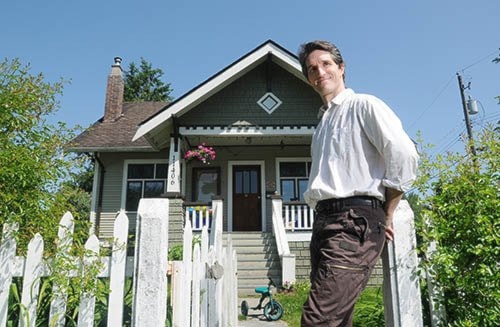James Rowley and Leanne Koehn call their old home the “Hammond Forever House” because, if renovated properly, it will last a long time.
And it may take forever to renovate, as the couple tries to save the heritage of the home built in 1923, and save energy and the earth by fitting it with the latest technology to lessen its carbon footprint.
But the financial challenges are daunting.
“What happens with many people, and it’s happened to us in the past – we do it piecemeal and the end product is much less. If we had the money to do it all at once, we’d save a lot of energy and we’d end up with a product we’d like to live in for the rest of our lives.”
Rowley said incentives for eco renovations of homes are geared towards people making a plan, doing the project all at once.
“But nobody can afford to do that. There needs to be a few more steps to help us get there.”
Rowley launched a blog called Hammond Forever House, detailing his predicament and to “inspire a community approach to the challenge of climate change.
“This is the story of the renovation and retrofit of a 1923 Craftsman-style cottage into Hammond Forever House” – says the blog.
“A house that heats and cools itself, conserves both energy and water, and keeps our family healthy and happy – on a budget. Can we do it? Watch us.”
The couple is also about to sign a heritage revitalization agreement with the district that will give them six years to restore the home while preserving its heritage.
Two years ago, Rowley introduced the Now House project to Maple Ridge. With the project, groups of homeowners were supposed to coordinate eco renovations and save thousands through economies of scale. But that didn’t work out.
As any homeowner will tell you, Rowley says one project leads to another.
For instance, there’s the small matter of replacing the ancient oil-burning furnace in the basement.
“So we have some questions for our readers. What kind of heating system do we use?”
Does he put in a high-efficiency natural gas furnace that puts a fraction of the hydrocarbons into the air compared to the old oil furnace? That would save energy, but still would mean using fossil fuels, he pointed out.
So what about an electrically powered heat pump?
Better yet would be a geothermal heating system, where coolant is pumped into the ground using the temperature of the earth to heat or cool the building.
“If I want to live in my house forever, that’s the way to go. But how do we pay for that?”
Insulating the walls is a tricky topic.
The exterior of the walls have to be preserved while the inside walls are beautiful panelling.
For now, they’ve blown in insulation but are stymied from doing more at the moment.
There are other projects, as well.
But many government grants that encouraged homeowners to do eco renovations are no longer available.
It’s now up to the community, as a whole, to find answers, Rowley says.
